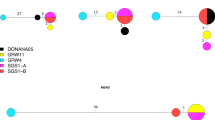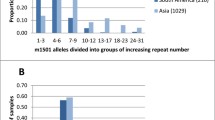Abstract
Microsatellites, short tandem repeats of nucleotides in the genome, are useful markers to detect clonal diversity within Plasmodium infections. However, accuracy in determining number of clones and their relative proportions based on standard genetic analyzer instruments is poorly known. DNA extracted from lizards infected with a malaria parasite, Plasmodium mexicanum, provided template to genotype the parasite based on three microsatellite markers. Replicate genotyping of the same natural infections demonstrated strong repeatability of data from the instrument. Mixing DNA extracted from several infected lizards simulated mixed-clone infections with known clonal diversity and relative proportions of clones (N = 56 simulations). The instrument readily detected at least four alleles (clones), even when DNA concentrations among clones differed up to tenfold, but alleles of similar size can be missed because they fall within the “stutter” artifact, and rarely does an allele fail to be detected. For simulations of infections that changed their relative proportions over time, changes in relative peak heights on the instrument output closely followed the known changes in relative proportions. Such data are useful for a broad range of studies on the ecology of malaria parasites.



Similar content being viewed by others
References
Anderson TJC, Haubold B, Williams TJ, Williams JT, Estrada-Franco JG, Richardson L, Mollineado R, Bockarie M, Mokili G Mharakurwa S, French N, Whitworth J, Velez ED, Brockman AH, Nosten F, Ferreira MU, Day DP (2000) Microsatellite markers reveal a spectrum of population structures in the malaria parasite Plasmodium falciparum. Mol Ecol Evol 17:1467–1482
Bruce MC, Donnelly CA, Alpers MP, Galinski MR, Barnwell JW, Walliker D, Day KP (2000) Cross-species interactions between malaria parasites in humans. Science 287:845–848
Bruce MC, Macheso A, Galinski MR, Barnwell JW (2007) Characterization and application of multiple genetic markers for Plasmodium malariae. Parasitology 134:637–650
Contamin H, Fandeur T, Bonnefoy S, Skouri F, Ntouni F, Mercereau-Puijalon O (1995) PCR typing of field isolates of Plasmodium falciparum. J Clin Microbiol 33:944–951
Ferreira MU, Karunaweera ND, da Silva-Nunes M, da Silva N, Wirth DF, Hartl DL (2007) Population structure and transmission dynamics of Plasmodium vivax in rural Amazonia. J Infect Dis 195:1218–1226
Imwong M, Sudimack D, Pukrittayakamee S, Osorio L, Carlton JM, Day NPJ, White NJ, Anderson TJC (2006) Microsatellite variation, repeat array length, and population history of Plasmodium vivax. Mol Biol Evol 23:1016–1018
Machado RLD, Povoa MM, Calvosa SP, Ferreira MU, Rossit ARB, dos Santos EJM, Conway DJ (2004) Genetic structure of Plasmodium falciparum populations in the Brazilian Amazon region. J Infect Dis 190:1547–1555
Paul REL, Packer MJ, Walmsley M, Lagog M, Ranford-Cartwright LC, Paru R, Day KP (1995) Mating patterns in malaria parasite populations of Papua New Guinea. Science 269:1709–1711
Paul REL, Hackford I, Brockman A, Muller-Graf C, Price R, Luxemburger C, White NJ, Nosten F, Day KP (1998) Transmission intensity and Plasmodium falciparum diversity on northwestern border of Thailand. Amer J Trop Med Hyg 58:195–203
Martinsen ES, Perkins SL, Schall JJ (2008) A three-genome phylogeny of malaria parasites (Plasmodium and closely related genera): Evolution of life-history traits and host switches. Mol Phy Evol 47:261–273
Nair S, Williams JT, Brockman A, Paiphun L, Mayxay M, Newton PN, Guthmann J-P, Smithuis FM, Hien TT, White NJ, Nosten F, Anderson TJC (2003) A selective sweep driven by pyrimethamine treatment in southeast Asian malaria parasites. Mol Biol Evol 20:1526–1536
Read AF, Taylor LH (2001) The Ecology of genetically diverse infections. Science 292:1099–1102
Reece SR, Drew DR, Gardner A (2008) Sex ratio adjustment and kin discrimination in malaria parasites. Nature 453:609–614
Schall JJ (1996) Malarial parasites of lizards: Diversity and ecology. Adv Parasitol 37:255–333
Schall JJ (2002) Parasite virulence. In: Lewis EE, Cambell JF, Sukhdeo MVK (eds) The Behavioural ecology of parasites. CABI Publishing, Oxon, UK, pp 283–313
Schall JJ, Vardo AM (2007) Identification of microsatellite markers in Plasmodium mexicanum, a lizard malaria parasite that infects nucleated erythrocytes. Mol Ecol Notes 7:227–229
Selkoe KA, Toonen RJ (2006) Microsatellites for ecologists: a practical guide to using and evaluating microsatellite markers. Ecol Lett 9:615–629
Vardo AM, Schall JJ (2007) Clonal diversity of a lizard malaria parasite, Plasmodium mexicanum, in its vertebrate host, the western fence lizard: role of variation in transmission intensity over time and space. Mol Ecol 16:2712–2720
Vardo AM, Kaufhold KD, Schall JJ (2007) Experimental test for premunition in a lizard malaria parasite (Plasmodium mexicanum). J Parasit 93:280–282
Vardo-Zalik AM, Schall JJ (2008) Clonal diversity within infections and virulence of a malaria parasite, Plasmodium mexicanum. Parasitology 135:1363–1372
Vardo-Zakik AM, Schall JJ (2009) Clonal diversity alters the infection dynamics of a malaria parasite (Plasmodium mexicanum) within its vertebrate host. Ecology 90(2):529–536
Acknowledgments
This work was supported by grants from the USA NSF and the Vermont Genetics Network. The Vermont Cancer Center provided valuable technical assistance. We thank B. Calsbeek for important assistance in conducting the experiments and C. W. Kilpatrick for advice throughout the study. All experiments conformed to a protocol from the Animal Care and Use Committee of the University of Vermont and collecting permits from the state of California.
Author information
Authors and Affiliations
Corresponding author
Additional information
Funded by: USA National Science Foundation and the Vermont Genetics Network.
Rights and permissions
About this article
Cite this article
Vardo-Zalik, A.M., Ford, A.F. & Schall, J.J. Detecting number of clones, and their relative abundance, of a malaria parasite (Plasmodium mexicanum) infecting its vertebrate host. Parasitol Res 105, 209–215 (2009). https://doi.org/10.1007/s00436-009-1385-1
Received:
Accepted:
Published:
Issue Date:
DOI: https://doi.org/10.1007/s00436-009-1385-1




